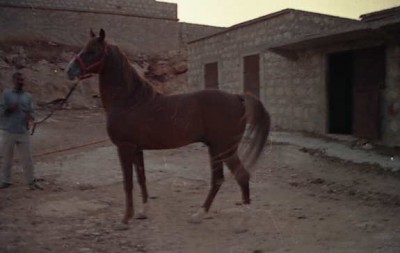Photo of the day: Al-Aawar, desert-bred Hamdani Simri stallion from the Shammar
This venerable, glorious horse, one of my all-time favorite stallions, will be featured in detail in an upcoming post, which I am taking my time to write. Meanwhile, enjoy the picture, which I took at twilight at Radwan Shabareq’s stud in Aleppo, Syria, sometime in the mid 1990s. Al Aawar was in his 20s.

I like this horse. He has his head up and neck turned, which isn’t the most attractive pose, but I think he would fit in well here.
You would have liked him so much more had you seen him in real life. He was striking and would leave a mark on you that never goes away. A true lord, who made you feel like you had to respect him.
Am looking forward to your article. And more pictures. 🙂
AnitaW who wished the *Jedah tail-female line had survived within the Davenports and the *Sherifa line within the Blunts.
Thanks Edouard for posting that picture of Al-Awar. I agree with you that he is much more impressive in person than in photos which explains my difficulty in getting a good photo of him at the Racing club in Aleppo, nearing dark time in November 1996. When a horse makes a good impression on me, I have great difficulty in wanting to take a photo because I want to spend every moment looking at the horse to record what I see in my mind, and taking photos requires me to think about the camera and capturing something quickly, which is an intrusion on the live experience, possibly missing an important moment. This is why in the 1970s we mostly took horse movies (before video) and usually Sharon was taking the movies as I was looking.
But Al-Awar is truly a horse that one needed to see in person. Even as an aged horse, his wonderful expression and temperament, light free movement as he was being ridden in front of us, and the rich sheen of his deep chestnut coat resembling some rare earthen stone, was unforgettable. In his harmonious presentation, I was reminded of Homer Davenport’s quote about “nothing to excess and everything in the right place.” It is not just the memory of him but also the legacy of Al-Awar as a sire, for he was used considerably for a tribal-bred of his time.
In looking at the photo you posted one can imagine that considering this horse’s build, the powerful quarters, strong back, smooth perfectly integrated shoulder, the proportions of his legs, long strong forearm and short canons, with powerful hind gaskins and the inherent overall strength combined with refinement would make a horse that can move effortlessly with lightning fast agility. He was a classic original Arabian to me.
Clearly Davenport breeders would admire him but also anyone who understands the traditional Arabian horse would also feel privileged to have seen such a wonderful stallion.
Speaking of taking photos with a camera or with an eye, Charles had the opportunity of seeing the Spanish Riding School in Chicago in the mid-50s, with Col. Podhajsky. He debated using his film camera to capture the performance, but decided he would rather film it with his eyes, and have the memory.
Jeanne, how true, how true. Those moments that make lasting impressions are still there years later. When we close our eyes we can still see them. I find this true even in old books with memorable images and descriptions. I remember the time I first saw the photo of “Old Speckled Jellaby” in Danah Al Khalifa’s book. It was for sale by a book vendor at the 1974 Arabian Horse Fair and I had to have that book just for that one photo of such a magnificent aged horse.
I came across the report of the WAHO Inspection & Investigation Committee in Syria, 2002, which has an appendix with the horses added to the Syrian Stud Book at the time. It lists several mares as Hamdaniet Ibn Ghorab – is this a case of Ibn Ghorab’s marbat producing such quality horses of the Hamdani Simri strain that they are now known by his name? Or just there not being enough space to fit Hamdaniet Semrieh Ibn Ghorab into the table?
The marbat is so famous so famous that everyone calls it by Ibn Ghurab’s name, except ibn Ghurab himself. Ibn Ghurab would use the name of the most famous previous owner’s name (Simri) to refer to the strain.
Thank you for the explanation! So Hamdani Ibn Ghurab is effectively a new substrain of the Hamdani Simri, like Saqlawi Jadran Ibn Sudan?
yes
what a terrific look this horse has, the attitude and so strong through the back and hindquarters with a long underline and short topline between where the wither finishes along the back and the loin. He looks like a rocket!
He is my favorite ever